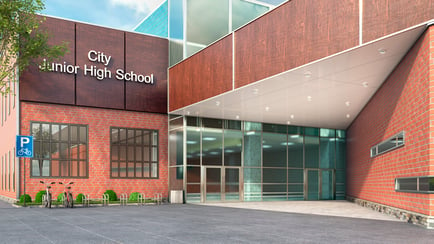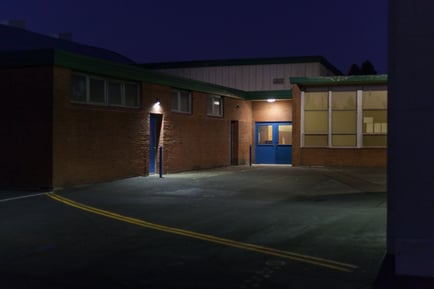As mass shootings – and school shootings in particular – have become commonplace across our nation, the need to improve security in our schools has perhaps never been so urgent. Many school boards and administrators want to improve school security but do not have adequate budgets to implement large-scale electronic or other physical security projects. If you find yourself in this position, you may want to consider applying the concepts of Crime Prevention Through Environmental Design (CPTED) to boost security at your school. CPTED involves the application of physical design features to discourage crime, while at the same time encouraging legitimate use of the built environment.
CPTED involves four main strategies – territorial reinforcement, natural surveillance, natural access control, and maintenance. In this article, I’ll explore territorial reinforcement strategies that can be applied to enhance school security.
What is Territorial Reinforcement?
Territorial reinforcement, sometimes called “defensible space,” is the use of physical attributes to create a strong sense of ownership and community. The use of territorial reinforcement as a crime prevention strategy is based on the premise that people instinctively protect a territory to which they feel connected. Buildings with a strong sense of territorial reinforcement successfully strike the balance between inviting legitimate users to the space while also sending a clear message that users with an illegitimate purpose are not welcome. Territorial reinforcement in a school setting would typically involve the clear demarcation of three zones:
- Public zone – the street or other public property surrounding the school property
- Semi-private zone – the sidewalk or walkway leading to the school that creates a buffer between the public and private zones
- Private zone – area where access is controlled and limited to authorized users
Several methods can be applied to achieve territorial reinforcement, including the use of fencing, signage, artwork and color, pavement treatments, landscaping, and flags. The image below represents a school with a design that provides a strong sense of territorial reinforcement through the use of signage, pavement treatments, landscaping, and lighting.
 Strong territorial reinforcement
Strong territorial reinforcement
In contrast, the school in the image below does not have a strong sense of ownership. It lacks the clear demarcation of public, semi-private, and private zones. There is no signage and the lighting is inadequate. One might wonder if the building is even occupied, leaving it vulnerable to illegitimate users.
 Poor territorial reinforcement
Poor territorial reinforcement
Let’s explore in more detail some of the strategies that can be applied to create a strong sense of territorial reinforcement at your school.
Territorial Reinforcement Strategies for Schools
Classroom Clustering. Grouping classrooms into clusters can help provide students with a sense of belonging and community while also creating interior zones that serve as partitions within the larger school. The clusters may be organized by grade level, learning community, or career pathway. These clusters help students feel a sense of ownership over their assigned area, thus fostering the protective and cooperative atmosphere that is at the heart of CPTED. It can also help students feel more familiar with the space, and safer in it.
Clustering is also an unobtrusive way to help teachers and staff reinforce boundaries and recognize potential threats more quickly. And in the event of an emergency, clustering allows specific areas to be secured more easily.
Fencing. Installing fencing around your school can be an important part of your territorial reinforcement strategy. Fencing can help outline and define school property and create a clear demarcation between the public and private zones. If installing fencing around the entire school property isn’t feasible, consider adding fencing around the area where playgrounds and/or athletic fields are located.
It’s also important to consider the type of fencing used. Fencing that meets CPTED recommendations is typically a minimum of six feet high and transparent so that it provides clear sightlines. Suggested fencing materials include tubular steel and wrought iron. The fencing should also have an anti-climb design, which doesn’t permit footholds.
Signage. Providing clear signage is another way to promote a strong sense of territorial reinforcement at your school. Signage with your school’s name can be featured on the building façade to create a sense of ownership. Pedestrian-scale signage should be visible throughout school property to improve wayfinding and to provide directives and expectations regarding the building’s usage. Directives should be easily understandable with large, bold font and graphics. Signage should be provided on all exterior doors, and should direct visitors to the main entrance and notify them of electronic surveillance. Signage should be designed such that it limits areas of concealment and does not interfere with natural surveillance. All signage should be illuminated at night.
Color and Artwork. Incorporating color and artwork can be an effective – and fun – way to enhance territorial reinforcement at your school. Public art comes in many forms and can help define a space and serve as a focal point for a site. Consider having students put their creative juices to use by creating murals, sculptures, or temporary artwork that is switched out from time to time. Fountains and flags are other ways to add artistic features and color to your school grounds.
Be sure that artwork is reflective of the local culture so that students, staff, and visitors can strongly identify and connect with it. Don’t be afraid of using bold colors on the building’s exterior- they’ll help create a clearly recognizable sense of ownership.
 Example of public art to enhance territorial reinforcement
Example of public art to enhance territorial reinforcement
Pavement Treatments. Consider using pavement treatments to help define the borders of public, semi-private, and private spaces. For instance, the public zone could be comprised of streets and sidewalks beyond school grounds. The semi-private zone, which leads to your school and creates a buffer between the public and private zones, could be comprised of concrete sidewalks or asphalt walkways. The private zone could be covered in an interesting pattern of stamped concrete, stone, brick, or other materials. Clearly defining the transition zones with the use of different colored and textured pavement treatments will help create a sense of territorial reinforcement on school property.
Landscaping. Landscaping can be an effective way to define boundaries and express ownership. Clearly marking the boundaries of the property using landscape features can deter illegitimate users from entering the site. Consider engaging the services of a landscape architect to develop the most effective design for your school. Note that it’s important to design landscaping in a manner that allows for unobstructed views of the surrounding area. And be sure to develop a maintenance plan for any landscaping features to preserve natural surveillance and to signal to users that there is a sense of ownership at the school.
Activities. Scheduling activities on school property encourages users with a legitimate purpose to use school grounds, which reinforces a sense of ownership and defensible space. Keeping the school active and vibrant within the community provides a clear signal that the school is occupied and cared for, and that any illegitimate use will be observed. This acts as a strong deterrent to criminal activity. During all activities held on school property, it is important that access to private areas remains restricted to authorized users only. It is also important that loitering and unauthorized after-hours use of school property be discouraged.
One Piece of the Puzzle
The recommendations I’ve described above are an important piece of the school security puzzle but are most effective when implemented as part of a comprehensive crime reduction strategy. Applying all of the CPTED principles – territorial reinforcement, natural surveillance, natural access control, and maintenance – in conjunction with physical and electronic security projects will provide the greatest level of protection for your school. As you work to secure the funding necessary to implement larger-scale security improvements, consider adding some of these smaller-scale territorial reinforcement strategies. Every piece of the puzzle helps create a setting that is conducive to learning while keeping all students, teachers, staff, and visitors safe. That’s a puzzle that’s worth piecing together.



.png)

-1.jpg)
.jpg)
.jpg)
.jpg)
-2.jpg)
.jpg)


.jpg)
.jpg)
.jpg)
.jpg)
.jpg)

